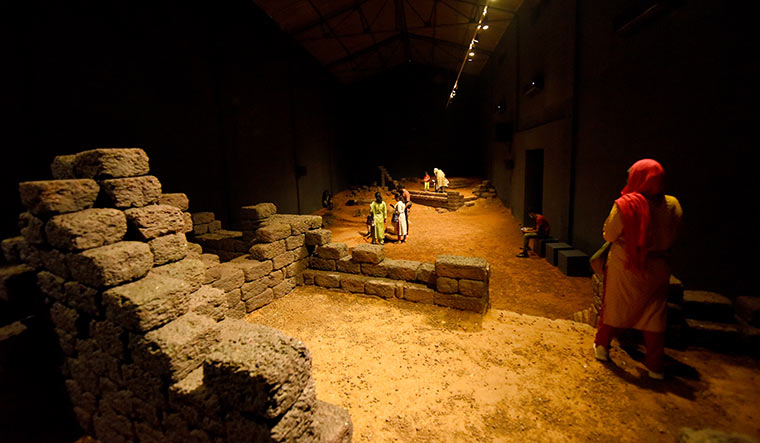Curdi was their home before the river swallowed it. Now, every summer, they return to see the remains of the Goan village that emerge as the water recedes under a hot sun. They clean the ruins and place vessels to symbolically reoccupy their homes. They sing to their land and the waters.
Goan artist Sahil Naik’s installation―All is Water and to Water We Must Return―at the ongoing Kochi-Muziris Biennale in Kerala, is based on this touching tale of displacement and homecoming.
Sahil’s installations explore global conflicts, displacement and the idea of nation building. His debut solo show in Kolkata, Ground Zero: Site as Witness/Architecture as Evidence (2018), focused on urban displacement and the ways in which modern Indian architecture inadvertently becomes witness to the stories of human generations.
The 31-year-old told THE WEEK that building ritualistic Narakasura (an asura king) effigies during Diwali was one of the earliest inspirations for him to become an artist. He was fascinated by Curdi’s landscape and dilapidated structures when he was a BFA student. The installation emerged from Sahil’s engagement with the original inhabitants of Curdi over the past nine years.
Goa was liberated from centuries-old Portuguese rule in December 1961. To commemorate Goa joining the Union of India, Dayanand Bandodkar, the first chief minister, announced a modernist dam on the Selaulim, a tributary of the Zuari river. There were concerns as the dam would take over several villages, including Curdi, and also mangroves, lush fields, water bodies and forests sacred to the local community. Curdi at the time was a prosperous agricultural village with around 3,000 residents. The government went ahead with the plan and resettled more than 450 families in Valkinem and Vaddem villages, which were higher than Curdi. As the people left their villages hesitantly, they touched the waters and asked it to protect their land. “On paper, it was a proper resettlement, but it was not proper,” says Sahil. “Some people did not receive what they had been promised.”
Curdi was soon gone, and life went on. However, during a summer in the early 1980s, the water receded and the village resurfaced. “Every year since, Curdi started reappearing for a month in the summer,” says Sahil. “So, all the Curdi residents scattered around Goa started coming back to see their lost homes, and to revisit their memories.”
Sahil’s installation is exhibited in Aspinwall House, a sea-facing property in Fort Kochi that is the prime venue of the biennale. Those entering the space will first encounter a broken-down house, through which they have to walk to reach Sahil’s landscape. There is a piece of land from which water has receded, an old well filled with debris, old bricks, vestiges of household items and remains of a tree that died along with the village.
The immersive installation is equipped with 5.1 surround sound, and three Konkani compositions expressing the pain of Curdi are played on loop. “That generation of Curdi is now old,” says Sahil. “There is a saying: ‘Histories may die with people, but a song, like hope, survives time.’ So, I collected all the stories of those people and I worked with three songwriters―Sayesh Purandarikar, Hemant Aiya and Brijesh Shet Desai―who converted these stories into compositions. The songs tell of how they had to leave the village, and the challenges they had to face.”
One of the compositions goes: “Everything is in ruins now, they took our houses to a hill and we became strangers in our own land, and our mother got submerged.” The songs were composed by Laxman Naik. “After creating these songs, we invited the original residents of the village to sing them,” says Sahil. “So, what you hear in the installation space is their voice, because it is their story and it does not make sense when anyone else sings it. The tunes were familiar to them, only the lyrics were new. So, my work also explores how songs act as a medium to remember.”



